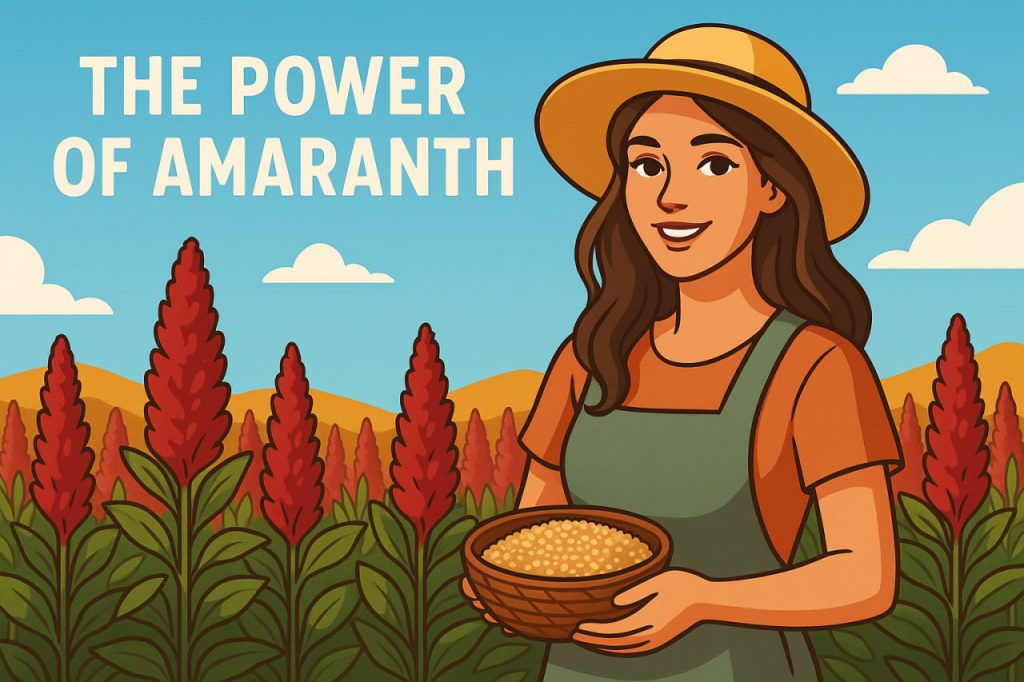Amaranth, a vibrant plant with striking red and gold flowers, is far more than a beautiful addition to nature’s palette—it is one of humanity’s oldest and most resilient food sources. Once revered by ancient civilizations for its nutritional and spiritual value, amaranth has reemerged as a modern superfood celebrated for its health benefits, versatility, and ecological sustainability. Though often called a grain, amaranth is actually a pseudocereal, like quinoa, meaning it is not a true cereal grain but produces seeds used in similar ways. From ancient temples of the Aztecs to health-conscious kitchens worldwide, amaranth’s journey reflects both the wisdom of the past and the promise of the future.
The Ancient History of Amaranth
Amaranth’s story begins thousands of years ago in Central and South America, where it was a sacred crop for the Aztecs, Incas, and Mayans. Known as huautli by the Aztecs, it was a dietary staple and used in religious rituals to honor their gods. Warriors consumed amaranth to gain strength and endurance before battles. However, when Spanish conquistadors arrived in the 16th century, they outlawed its cultivation, viewing it as a symbol of pagan worship. Despite this, small indigenous communities continued to grow amaranth secretly, preserving it through centuries. Botanist Dr. Camila Rivera notes, “Amaranth’s survival against cultural and environmental challenges mirrors its resilience as a plant—it thrives where others fail.”
Nutritional Value: A True Superfood
Amaranth is a powerhouse of nutrition. It is rich in protein, containing all nine essential amino acids, including lysine, which is rare in most grains. It also provides iron, magnesium, fiber, calcium, and vitamin E, making it a complete food for both physical and mental vitality. Its high content of antioxidants and polyphenols supports heart health and boosts the immune system. Because it is naturally gluten-free, it’s ideal for people with celiac disease or gluten intolerance. Nutrition expert Dr. Leandro Santos explains, “Amaranth is a perfect blend of ancient nutrition and modern dietary needs—it delivers energy, balance, and sustainability in one seed.”
How Amaranth Grows and Thrives
Amaranth is remarkably adaptable and can grow in poor soils, high altitudes, and dry climates, making it a sustainable crop in the face of global warming. Its drought resistance and short growing cycle allow it to thrive in regions where traditional grains struggle. The plant can reach up to two meters tall, with bright clusters of flowers that produce thousands of tiny seeds. Beyond the seeds, the leaves of amaranth are edible and rich in nutrients, often compared to spinach. This dual-purpose nature—both as a grain and leafy green—makes amaranth a vital crop for food security in developing countries.
Amaranth in Modern Cuisine
Today, amaranth has found its way into global cuisine. Its nutty, slightly earthy flavor pairs well with both sweet and savory dishes. It can be cooked like rice, popped like popcorn, or ground into flour for bread, pancakes, and pastries. Amaranth porridge has become a favorite breakfast option for health-conscious individuals, while chefs use amaranth seeds as a base for salads, soups, and plant-based burgers. In Mexico, puffed amaranth is mixed with honey to make alegría, a traditional sweet treat meaning “joy.” This ancient snack continues to connect modern eaters to the cultural roots of the crop.
Cultural and Environmental Significance
Beyond its nutritional value, amaranth represents sustainability and cultural revival. Its ability to grow with minimal water and fertilizers makes it an eco-friendly alternative to conventional crops like wheat and corn. As climate change threatens agricultural stability, amaranth is being recognized as a key solution for sustainable farming. The Food and Agriculture Organization (FAO) has praised amaranth for its potential to combat hunger and malnutrition worldwide. Culturally, its resurgence also symbolizes respect for indigenous knowledge and traditions that valued biodiversity long before modern science.
The Future of Amaranth
As scientists and farmers continue to explore sustainable food sources, amaranth stands out as a crop of the future. Researchers are studying its genetic structure to improve yields and develop varieties suited to diverse climates. Its resistance to pests and environmental stress makes it ideal for sustainable agriculture in developing regions. Meanwhile, health industries are promoting amaranth as a natural ingredient in protein powders, gluten-free products, and plant-based diets. The rediscovery of amaranth marks not only a nutritional renaissance but also a shift toward harmony between human health and the planet’s wellbeing.
Interesting Facts
- The word “amaranth” comes from the Greek amarantos, meaning “unfading,” symbolizing immortality.
- Amaranth can be popped like popcorn, creating a light and crunchy snack.
- Ancient Aztec rituals used amaranth dough shaped into figures of gods.
- The plant’s red pigment contains betacyanin, a natural antioxidant.
- Some species of amaranth are considered ornamental for their vibrant red and purple flowers.
Glossary
- Pseudocereal — A plant that produces edible seeds used like grains but is not part of the grass family.
- Lysine — An essential amino acid necessary for tissue repair and growth.
- Polyphenols — Natural compounds with antioxidant properties that protect cells from damage.
- Sustainability — Practices that maintain ecological balance and conserve natural resources for future generations.
- Alegría — A traditional Mexican sweet made of puffed amaranth and honey.


